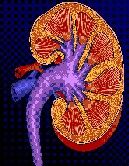Article
Top 5 Recently Published Articles on Hyponatremia
Brief summaries of research results and other articles on the clinical characteristics, evaluation, and management of patients with hyponatremia.
Below we present brief summaries of research results and other articles on the clinical characteristics, evaluation, and management of patients with hyponatremia.

The authors of the article “Hyponatremia May Reflect Severe Inflammation in Children with Febrile Urinary Tract Infection,” published in Pediatric Nephrology, note that hyponatremia “is the most common electrolyte abnormality in clinical practice, but little is known about the association between febrile urinary tract infection (UTI) and hyponatremia or its significance to clinical outcomes.” They looked at data from 140 children diagnosed with febrile UTI, including white blood cell (WBC) count, Technetium-dimercaptosuccinic acid (DMSA) scintigraphy, and C-reactive protein (CRP) levels. They reported that children with renal cortical defects diagnosed after DMSA scintigraphy, had a “significantly longer” duration of fever and “significantly higher” WBC and CRP levels, compared to patients without renal cortical defects. However, they found that patients with renal cortical defects had much lower serum sodium levels and more frequent hyponatremia. Serum sodium concentration was negatively correlated with WBC count and CRP levels. The authors concluded that these results indicate that hyponatremia “may be a substantial inflammatory marker and is significantly and independently associated with the degree of inflammation in children with febrile UTI.”
Peritoneal Dialysis and Hyponatremia
The authors of “Characteristics and Clinical Outcomes of Hyponatremia in Peritoneal Dialysis Patients,” published in Nephrology, looked at 387 patients who underwent peritoneal dialysis (PD). During the study period, 99 patients had “normonatremia” and 288 developed hyponatremia (defined here as sodium <135 mmol/L). OF these patients, there were 71 cases with appropriate water gain and 170 cases with non-appropriate water gain (where appropriate water gain is defined as more than a 3.6% increase of the mean total body water during normonatremia). The authors wrote that “Low residual renal function and long duration of PD were associated with development of hyponatrema by appropriate water gain.” They also reported that being age 65 years and older, hypoalbuminemia, low residual renal function, and/or a “high comorbid condition” were all associated with mortality in this patient cohort. They concluded that “prevalence of hyponatremia increases along with the increased comorbidity status. The comorbidity conditions may be more important than hyponatremia per se for predicting mortality. Additionally, the preservation of residual renal function may play a role in preventing hyponatremia.”
Causes of Hyponatremia in Patients Presenting to the Emergency Department
The authors of “Epidemiology and Characteristics of Hyponatremia in the Emergency Department,” published in the European Journal of Internal Medicine, looked at “the underlying causes and management of hyponatremia in an unselected population presenting with hyponatremia to the emergency department.” They performed a database search for patients who presented to emergency departments in two Swedish cities and who had hyponatremia (sodium <135 mmol/L), dividing the patients into four groups:
- Group 1: sodium <120 mmol/L
- Group 2: sodium 120—124 mmol/L
- Group 3: sodium 125—129mmol/L
- Group 4: sodium 130—134 mmol/L
They reported that hyponatremia prevalence was 3% in this cohort. They also found that “a single underlying cause was identified in 45% of patients in Group 1,” with thiazide diuretics, SIADH, and other diuretics being the leading causes. They also found that “the likelihood of being on thiazide diuretics increased with hyponatremia severity, with patients in Group 1 being more than 3.5 times more likely to be taking thiazide diuretics than patients in Group 4. In-hospital mortality was 2-7% for this cohort. In their discussion of these findings, the authors wrote that “Thiazide diuretics and SIADH were dominating underlying causes of hyponatremia, however, the frequency of adequate diagnostic testing was low. The majority of patients were treated with sodium chloride infusion.”
Hyponatremia, ESLD, and the Vaptans
“Hyponatremia in Cirrhosis and End-Stage Liver Disease: Treatment with the Vasopressin V2-Receptor Antagonist Tolvaptan,” published in Digestive Diseases and Sciences, looked at outcomes in cirrhotic patients with hyponatremia and in hyponatremic patients awaiting liver transplantation, the evaluation and management of patients with symptomatic and asymptomatic hyponatremia, the clinical characteristics of vasopressin receptor antagonists, the effectiveness of tolvaptan for managing hypervolemic and euvolemic hyponatremia, and the use of tolvaptan in patients with cirrhosis and end-stage liver disease (ESLD). The authors wrote that “Hyponatremia is common in patients with cirrhosis and ESLD and is associated with increased risk of morbidity and mortality. Mortality is significant in patients on liver transplant waiting lists and correlates with hyponatremia. Adjusting MELD scoring for hyponatremia improves the prediction of mortality in waiting list patients and may result in more appropriate allocation of grafts. The selective oral vasopressin V2-receptor antagonist tolvaptan acts to increase free water excretion and is effective in resolving hyponatremia in patients with cirrhosis and in others with hypervolemic or euvolemic hyponatremia. Tolvaptan and other vasopressin antagonists have the potential to improve outcomes in these patient populations.”
Hyponatremia and Hypothyroidism
In “Hypothyroidism as a Cause of Hyponatremia: Fact or Fiction?”, published in Endocrine Practice, the authors looked at whether severe primary hypothyroidism alone can cause hyponatremia in otherwise healthy ambulatory patients. A chart review identified 10 patients with primary hypothyroidism and “same-day serum thyroid-stimulating hormone (TSH), sodium, creatinine, and calculated glomerular filtration rate (GFR).” All patients had TSH >100 μU/mL. The authors reported that median TSH was 193 μU/mL and median sodium was 138 mmol/L in these patients. Median GFR was 67.5 mL/min/1.73 m2. Out of this small cohort of patients “with extreme TSH elevations,” not one “had a serum sodium level below normal (<135 mmol/L), even in the presence of a reduced GFR.” The authors concluded that although hyponatremia “can be a common occurrence in hospitalized and/or chronically ill patients,” in an “otherwise relatively healthy ambulatory patient, hypothyroidism, even when severely undertreated, may be a less clinically relevant cause of hyponatremia.”




